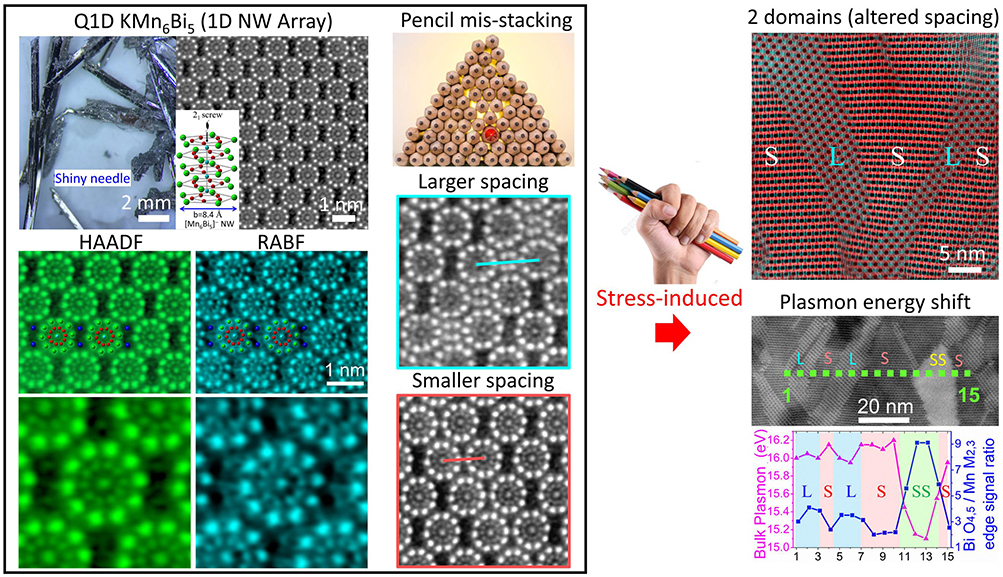Betrayal of classical atomic defect mechanism in a Quasi-1D material

Defects are common in materials that we use every day. The materials deform or break over time by defect mechanism, and there has been a long-time belief that defects in materials occur only atom-by-atom displacement. However, recent discovery tells the classical defect theory can be myopic in very rare quasi-1D (Q1D) system; you will find something unexpected.
Most of the current 1D materials are not truly 1D in dimension in regards to their diameters, while 2D materials are strictly determined to be few-atomic layer thickness. On the other hand, Q1D structures have a genuine 1D motif, which is an intrinsic part of the innate bulk cm-scale crystal applicable to practical devices. Thus, extraordinary anisotropic 1D properties toward the longer axis, which can be achieved in only true 1D, can be maintained in bulk Q1D crystal.
A Q1D KMn6Bi5 bulk crystal is a shiny needle, composed of the compact array of nanowires (NWs) with sub-nm diameter but cm-long length. Each long 1D NW acts as one hard body and shows displacement of a linear set of NWs against the classical atomic displacement. The mechanism is similar to when one grabs a bundle of pencils (i.e., NWs) strongly. Here, each pencil behaves as a unit that slides across/around to accommodate differential stress. Interestingly, there are two types of inter-NW defects towards a different direction in the Q1D KMn6Bi5. One defects expand inter-NW spacing by Bi invasion between NWs, while the other defects shrink inter-NW spacing by sliding in. Such an unconventional inter-NW defect mechanism was discovered for the first time, published in Nano Letters.
Researchers intuition leads to inducing additional stress to this system by local indentation. And it turned out that two distinctive domains form by these two inter-NW defect mechanism. The further interesting finding was the bulk plasmon energy shift in those domains. Bulk plasmon, which is a harmonic resonant oscillation of electrons against incoming kinetic particles, is believed to be determined by only atomic configuration in bulk, but it is the first time to show that motific configuration by different inter-NW spacings can also alter bulk plasmon in the local territory. Because bulk plasmon is related to the optical property of the system, the fact that same atomic composition but with different motific spacings can give plasmon shift would give unique inspiration to the photonic, optic and plasmonic field. Because there has been no defect research in the very rare quasi-1D system, this study may pave the road to comprehend structure-defect relationship, and eventually defect-property correlation in other Q1D.
Dr. Hee Joon Jung, who is the first author of this research, depicted his moment of discovery: "It was a very exciting moment to see unexpected defects. At first glance, when X shaped lines in Q1D were observed at ow magnification, some prejudice was kicked ins o that I thought it would be atomic defects or some imaging artifcat. However, when I zoomed in at atomic scale, it turns out there was no atomically-broken NW but alternated spacings between NWs. Furthermore, one diagonal line is related to Bi intrusion expanding inter-NW spacing, whereas the other diagonal line is related to meek shrinkage of inter-NW spacing. The imrpession was like mis-stacked pencil bundles. Unconventional defect structures are revealed by very high-quality abberation-corrected scanning transmission electron micrscopy (AC-STEM) images and corresponding multislice simulation. The study once again proves the power of AC-STEM as prespiacious accoutrement for interpreting complex structures."

